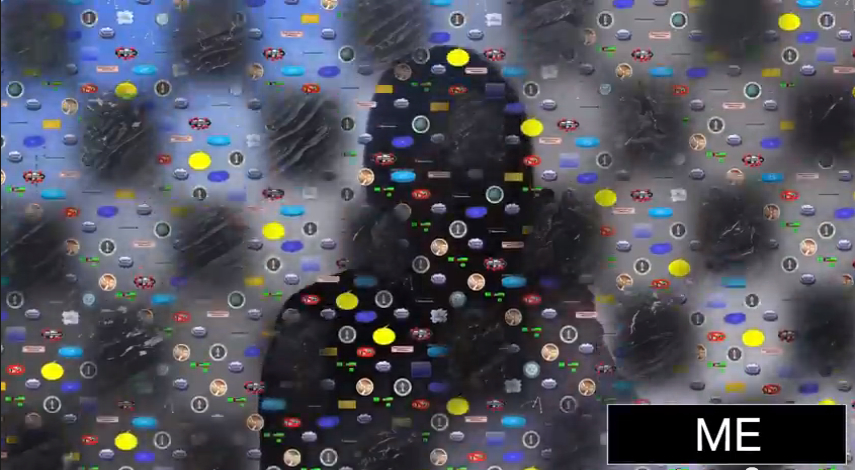
Screen grab from "Home," by Holly Herndon
Over the last year or two, I’ve gradually found myself doing something that I hadn’t done with much regularity since college: watching music videos.
Of course, I haven’t been tuning into some modern equivalent of 120 Minutes on a television set to learn about new bands. I'm watching these clips online, and often I’m not even interested in the music. I’m interested in the aesthetics.
While it’s obvious enough that the digital age has rewired the manner in which music videos get around, I’ve been drawn to the way technology is shaping the way many of them actually look. That can mean explicitly tech-oriented visual themes; computer-generated image trickery; experiments in scientfic visualization; digital animation; clever uses of the latest innovations or off-the-shelf gizmos; or various combinations of the above.
Eventually I began collecting examples that caught my eye, and I’ll share a few here. Believe it or not, the list that follows is truncated: the clips below and many more can be viewed on this YouTube playlist and (for those not on YouTube) this Vimeo channel.
Holly Herndon’s video for “Home,” directed by Metahaven (via Prosthetic Knowledge), is a perfect place to start. “I can feel you in my room,” she sings—shortly before logos associated with various NSA programs rain down over her. It’s a lovely and provocative matching of image, sound, and idea.
A striking clip for the song “Come Closer,” by Emmy Curl (via Creators Project), directed by Nuno Barbosa, uses a project-mapping technique to cover the singer’s visage with abstract patterns—and with additional images of the singer herself.
A similar process, supplemented by glitch effects, gives the video for “Shore,” by Sylas, an intriguingly haunting vibe. (Note that the scantily clad dancer might make this one not safe for work.) The director is Jacek Zmarz.
To follow the glitchy theme for another beat, in 2013, producer Arca released a mix called &&&&&. Later, a portion of that mix was “visually interpreted” by director Jesse Kanda, and shown at MoMA PS1. In early 2014, what was described as the “first scene” of that “ongoing film project,” made its way online under the title “Trauma Scene 1.”
That video (via Huh), reads to me like a cross between the old-school “dancing baby” meme and an episode of American Horror Story.
Similarly, the seductively creepy images in HNN’s “Je Pars,” directed by Hugo Arcier, are apparently all digital—made by “manipulating photo-realistic renders of human bodies,” according to Dezeen. In short order, the human-esque figures become little more than ghostly, twisting digital skins, more striking for what’s missing than what’s there.
Okay, let me lighten things up. Since I’m on the record with my interest in waveforms, it’s probably not surprising that I was drawn to a video titled “Cymatics,” and consisting entirely of elaborate experiments—described in geeky detail here—in visualizing sound. The music is by Nigel Stanford; the director is Shahir Daud. Via Colossal.
Another experiment in science and visualization: “Great Equator,” by Zammuto. Nick Zammuto deploys “microscopy” to capture, via microscope, images of scratched vinyl, audio tape, a touchpad surface, and so on, Motherboard explains.Max Cooper’s “Seething” (via BoingBoing) offers a different sort of riff on what the naked eye can’t see, with a “digital simulation” of cell generation. I don’t remotely understand how the resulting shapes are generated, but it’s remarkable how these abstractions morph from cute to vaguely disturbing.
Back in the real world, the spinning-camera and editing trickery in the video for Metronomy’s “Month of Sundays,” directed by Callum Cooper, is fun to look at. But the clip is really made by the backdrop: the Brutalist architecture of the Barbican Estate in London. Via Dezeen.
Surely the GoPro camera is one of the trendiest tools in contemporary image-making. It’s put to fairly impressive—“psychedelic,” according to Peta Pixel—use in the video for “Rillo Talk,” by Wild Child. Directed by Aaron Brown, it specifically uses a GoPro “360” rig that collapses images into surreal little spherical worlds.
But my favorite bit of digital-image-era appropriation has less to do with a tech tool than with source material: The video for DJ Rashad Harden’s “She A Go,” constructed by Peter Greenless, borrows one of the absurd visual resources of our time—boring stock-agency imagery. Cubicle workers smile and dance unconvincingly, and every so often their faces are violently morphed and distorted. It’s both funny and unsettling—a winning combination. Via BoingBoing.
Lots of people are doing great animation work for music videos lately, digital and otherwise. But here’s a particularly notable example, via Core77: “Knock Knock,” by Brunettes Shoot Blondes, has its animated story play out across the screens of fourteen different devices.
Mattis Dovier created the animation for Plurabelle’s “Our Fires” video, giving us the black-and-white look and feel of an adventure game on early Mac (even though it’s actually more sophisticated, and, at times, a bit darker). Via Creative Review.
As a wildcard: Boing Boing wondered whether Hitchhiker’s “11(Eleven)” is best or worst video ever. An insane parade of non-sequitur CGI dancing, led by figures in silver space suits, it’s not for everyone—nor is the obnoxious music it brings to life—but I find it hilarious and pleasing. It’s a riot, in more ways than one.
Finally, any discussion of the art of music videos these days is incomplete without an acknowledgment of FKA twigs, whose stunning clips often feature jarring and extremely effective visuals, and have doubtless help make her a star. Slate calls her “the queen of music videos” in this brief item pegged to her clip for the song “Video Girl.”
But I’ll point to something a little different: “#throughglass” (via Salon), described variously as a collaboration with Google Glass, a “concept film,” or simply a de facto ad, depicts the singer using the device to conjure dance partners into a space that’s sort of virtual, and sort of real. It’s impressive in its success at making this rather silly gizmo appear, for once, fascinating.
Somebody should really assign a profile of FKA twigs focusing explicitly on the way she integrates her musical and visual ideas. Just this past week she released a new video for a song called “Pendulum” that nicely illustrates her signature integration of digital effects into already-striking narrative aesthetics.
I’ve added that clip, in fact, to a brand new playlist of 2015 art/tech music videos that I’ve decided to make, and update as new examples emerge. This should be another interesting year for looking at music.

